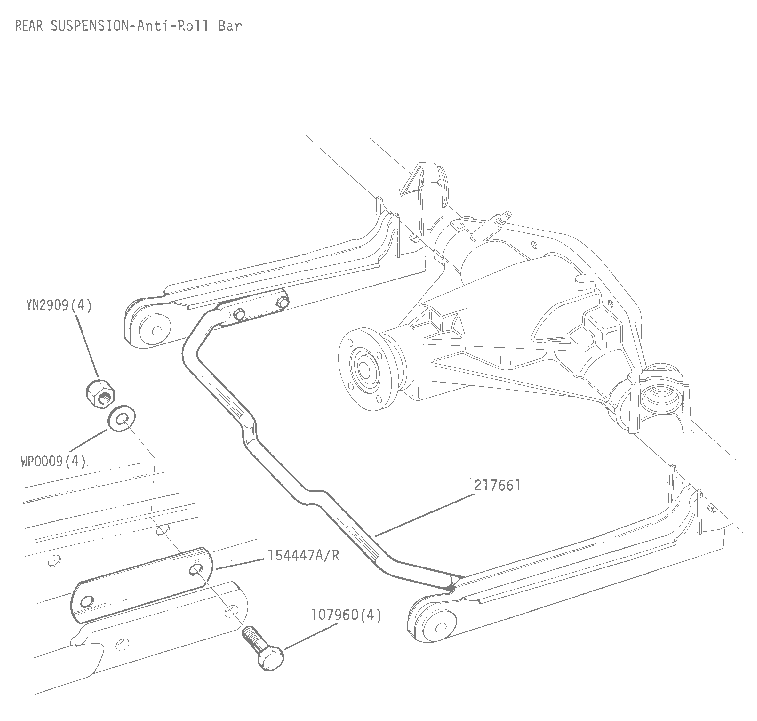The filler cap always looks like it won't fit under the bonnet, it will, beleive me.
The rear ARB should point to the front like so :-

Well spotted Stu.


If it does hit the bonnet adjust the engine steady bar a bit. The engine mounts will sag a bit anyway so if you leave putting the bonnet on til the end it should clear nicely.straylight wrote:thanks for the encouragement on the filler cap. One of those extra niggling doubts !
I'd take option 2 and leave the interior 'til last, but is six and two threes reallystraylight wrote:wondering whether to go full tilt at the interior now, or build up to an engine start, confirm that side works, then tackle the interior.
Here's a list to get you started. Corrections & regional variations welcomed.straylight wrote:Got seperate circuits for each of the purple wires and each of the green wires, spread some of that 35 amp load love around into smaller fuses. I'll get busy with the multimeter and work out exactly which parts of the purple and green circuit do what later. For now I can just put in 25 amp fuses.
I quickly put in a few of the power ratings that I could easily get. Just to get an idea of the max current draw. Forgive my laziness in equating amps to watts, bad practice, but just getting a rough idea.There are 6 wires on the right side of the box, anybody care to confirm or correct the following? Or add the ratings?
Purple 1:
- Hazard lights 21W x 4 = 84W = 7 Amps
- Cigarette lighter 50W max = 5 Amps (guessing it could be used to power a spotlight !)
- Clock bugger all
- Boot light 2.2 W = 0.18 Amps
- Courtesy light 5W = 0.42 Amps
Total 12.6 Amps
Purple 2:
- Horns ?
- Passing headlight flash 55W x 2 = 110W = 9.2 Amps
Green1:
- Reversing lights 21W x 2 = 42W
- Overdrive ?
Green 2:
- Windscreen wiper park function
Green 3:
- Windscreen wiper
- Windscreen washer
- Heated rear window
- Brake lights 21W x 2
- Blower
- Seatbelt warning
- Tachometer
Green 4:
- Voltage stabiliser which then does:
- Fuel gauge
- Temp gauge
So you could fuse the above groups by just moving wires at the fusebox. Then there is:
Unfused, supplied by a white wire on the left of the fusebox:
- Choke warning
- Handbrake warning
- Fuel warning
- Oil warning
- Brake balance warning
- Voltage gauge
- Ignition circuit
Which could be fused. Other white wire on the left is the feed from the ignition switch. Lastly there is:
Unfused, supplied from the splitter on the positive battery lead:
- All interior illumination
- All headlights
- All side lights
- Number plate illumination
None of my manuals show how fog lights are fed. If you want to break up these groups you need to find the splits in the loom or knit a new one. Draw lots of pictures with dimensions of the runs if you do please.
Tinweevil
so I'm guessing the Nulon 85W-140 I've used is a bit dumb....Hello, take care it is a gl4 you are going to use. A gl5 is for diffs and modern gearboxes. The gl5 is too good for the triumph gearboxes. When you use a gl5 the synchromesh cant' cut the strong oilfilm of the gl5. Your gears can't be synchone speed and that causes lot's of wear. Some gl4 have sulfide in it. Watch out not to use these. The sulfide reacts with the bronze synchro rings and the layshaft trustwashers. These will corrode almost to black. When overhauling a gearbox with black synchro's and washers you did use the wrong oil.
Sometimes people are not sure if there is sulfide in the gl4 and then they use 20w50. This is not the best option but when you are not sure of your gl4 it is better to use 20w50.
Almost all the mineral gl4 gearboxoils of the known populair brands don't have sulfide and can be used. The semi synthetic and full synthetic have most of the time sulfide.
Jeroen